

A banking void: Microfinance for the less fortunate. The new Modaraba will offer agricultural financing to low-income farmers on affordable terms.

PHOTO: FILE Access to finance brings a significant change in the life of a household that had previously been denied of such an opportunity. In most cases, the less fortunate need only a small amount of cash to help them jump start their business. For example, someone may need a meagre sum of Rs10,000 to begin a small trade. For example, a man may need a cart, a gas cylinder and balloons to start a microbusiness of selling helium-inflated balloons.
Markus @ Opportunity in Colombia. Rethinking how we give. Using Mobile Banking for New Microfinance Business Models. CGAP research published earlier in 2013 posited that the lines between microfinance and mobile banking are beginning to blur: Mobile banking has facilitated a new approach to microfinance by using the mobile phone, customer usage data and agents for loan applications, customer due diligence, and credit decision-making.
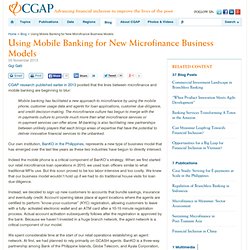
The microfinance culture has begun to merge with the m-payments culture to provide much more than what microfinance services or m-payment services can offer alone. M-banking is also facilitating new partnerships between unlikely players that each brings areas of expertise that have the potential to deliver innovative financial services to the unbanked. Our own institution, BanKO in the Philippines, represents a new type of business model that has emerged over the last few years as these two industries have begun to directly intersect. Indeed the mobile phone is a critical component of BanKO’s strategy. The Lab Collective. Price Transparency in Microfinance: How Much Does a Loan Really Cost? Price Transparency in Microfinance: How Much Does a Loan Really Cost?

With MFTransparency’s recent fifth anniversary, this week we are featuring some of their most important resources and initiatives. When considering buying a product or service, it is only fair to expect that one is told and is fully aware of the true cost before making a decision. Microfinance clients deserve to know the true prices of the products offered to them, just like any other consumer.
The Lab Collective. How Cell Phones Are Transforming the World of Microfinance. The middle class and wealthy have banks to lend them money.
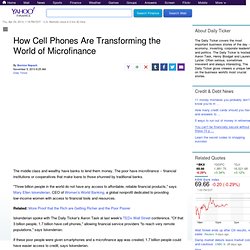
The poor have microfinance -- financial institutions or cooperatives that make loans to those shunned by traditional banks. "Three billion people in the world do not have any access to affordable, reliable financial products," says Mary Ellen Iskenderian, CEO of Women's World Banking, a global nonprofit dedicated to providing low-income women with access to financial tools and resources.
Related: More Proof that the Rich are Getting Richer and the Poor Poorer Iskenderian spoke with The Daily Ticker's Aaron Task at last week's TEDx Wall Street conference. "Of that 3 billion people, 1.7 billion have cell phones," allowing financial service providers "to reach very remote populations," says Iskenderian. If these poor people were given smartphones and a microfinance app was created, 1.7 billion people could have easier access to credit, says Iskenderian.
Related: How Americans Will Adapt to Lower Living Standards Tell Us What You Think! What Does Best Practice Microfinance Look Like? - FundForum - The World's Leading Asset Management Event Blog. Peter Ryan, CEO of The MicroLoan Foundation, speaks with us about his work in Microfinance.

Peter spoke recently in a session on Impact Investing at the 2013 FundForum International event. Like International Aid, Microfinance has come under fire recently, but Peter Ryan describes what to look for in a “good microfinance” organisation that develops small self- sustainable businesses in Sub-Saharan Africa. Watch our interview with Peter, and read the full article below. By Peter Ryan The lion’s share of the population in Sub Saharan economies still remains unbanked. We make small loans to poor women in the deep rural areas of Malawi and Zambia, so that they set up and develop small self- sustainable businesses, the profits of which feed their families and pay for clothing, housing, education and medicines.
The Lab Collective. The Lab Collective. Risky Assumptions to Avoid about Microfinance Borrowers. Oops!
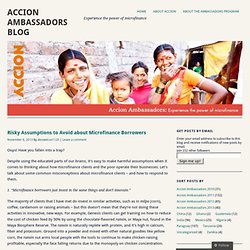
Have you fallen into a trap? Despite using the educated parts of our brains, it’s easy to make harmful assumptions when it comes to thinking about how microfinance clients and the poor operate their businesses. The Lab Collective. The Lab Collective. The Lab Collective. The Lab Collective. The Lab Collective. Microfinance CEOs Make Six Major Commitments at 2013 Partnerships Against Poverty Summit. > Posted by Anne Hastings, Manager, Microfinance CEO Working Group The CEOs of eight leading global microfinance networks – Accion, FINCA, Freedom from Hunger, Grameen Foundation, Opportunity International, Pro Mujer, VisionFund International, and Women’s World Banking – made six significant commitments at the Microcredit Summit Campaign’s Partnerships Against Poverty Summit last week in Manila.

These eight CEOs make up the Microfinance CEO Working Group. Together they represent more than 250 retail microfinance institutions in 70 countries globally and provide financial and often non-financial services to more than 40 million families. Here are the commitments: 1. 2. 3. 4. Global Development Professionals Network.
The Lab Collective. One Year After Sandy: How Microfinance Loans Helped Re-building Efforts. Kamal Elsayad in his Brooklyn store.
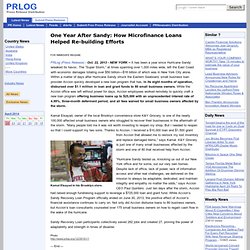
PRLog (Press Release) - Oct. 22, 2013 - NEW YORK -- It has been a year since Hurricane Sandy wreaked its havoc. The “Super Storm,” at times spanning over 1,000 miles wide, left the East Coast with economic damages totaling over $50 billion—$18 billion of which was in New York City alone. Within a matter of days after Hurricane Sandy struck the Eastern Seaboard, small business loan provider Accion quickly developed a new loan program that has, in its eight months of operation, disbursed over $1.1 million in loan and grant funds to 80 small business owners. While the Accion office was left without power for days, Accion employees worked remotely to quickly craft a new loan program offering business loans up to $25,000 with an unprecedented interest rate of 4.99%, three-month deferment period, and all fees waived for small business owners affected by the storm.
Global Development Professionals Network. MICROFINANCE PAPER WRAP-UP: “Microfinance in Africa: Opportunities for Social Entrepreneurs;” by Daniel Schriber; Published by The African Business Review. “Microfinance in Africa: Opportunities for Social Entrepreneurs,” by Daniel Schriber, Published by The African Business Review, May-June 2013, In this paper, Daniel Schriber, the director of the research and advisory arm of Switzerland-based Symbiotics, argues that although economic growth in Africa has been lagging for years, it finally surged due to factors including the expansion of the commodities sector.
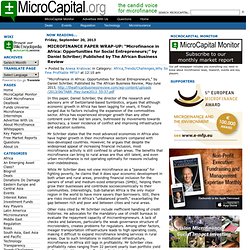
Africa has experienced stronger growth than any other continent over the last ten years, buttressed by movements towards democracy, a lower incidence of conflict and improving infrastructure and education systems. Mr Schriber states that the most advanced economies in Africa also have higher growth in their microfinance sectors compared with less-developed countries. However, he argues that despite the widespread appeal of increasing financial inclusion, most microfinance activity is still confined to urban areas. By Anesa Kratovac, Research Associate. The Economist explains: How can cows be good savings vehicles? Microfinance brings smiles to these beautiful faces of Oaxaca. Juana Chavez Ruiz works at her loom behind the Dulizun Cafe run by her granddaughter-in-law, Teresa Lopez Montano, in Teotitlan, near Oaxaca City, Mexico.

Microfinance: Empowering or exploiting the poor? We’ve all heard about microfinance, the practice of giving small loans to the poor to boost their small businesses. Muhammed Yunus, widely considered the godfather of microfinance, won the Nobel Peace Prize a few years ago. But since then, microfinance has attracted ever-louder critics who see the institution as more exploitive, trapping the impoverished in cycles of debt, than empowering. Kenyan Microfinance Firm Named Among Top 100 Global IT Frontrunners. Kenya, September, 02 2013 - Kenya’s Juhudi Kilimo, a microfinance institution, has been recognized as one of the top global IT firms in 2013 due its remote credit assessment service. Juhudi Kilimo generally offers financing to smallholder farmers and enterprises for a variety of income-producing assets. Unlike traditional microfinance, which primarily provides loans for working capital to informal businesses, Juhudi finances specific agricultural assets that offer immediate and sustainable income for farmers.
Juhudi Kilimo emerged as the only African enterprise featuring on the CIO 100 Global winners list where it was named among companies such as Boeing Corporation, IBM, Intel Corporation and Verizon Wireless. Its management system, Juhudi Kilimo Farmer Leads Management System (FLMS), operated by Samsung Galaxy Tablets, was also picked out for special praise. Prove It: Measuring Gender Performance in Microfinance.
As Nancy Lee articulated in the opening post of this series, women entrepreneurs face significant barriers accessing financial services. Recognizing that this exclusion has negative implications for women’s businesses, households and communities, the microfinance industry has thus held helping women overcome these barriers as a key part of its mission. Indeed, an analysis of MIX data has found that most microfinance institutions (MFIs) claim to target women (74%) and just over half declare women’s empowerment or gender equality as an objective. Yet, if we are going to have a meaningful discussion around gender and finance, we must have the ability to hold ourselves accountable to the financial inclusion and empowerment principles we advocate.
Photo Credit: Supriya Biswas. Microfinance. Columbia Business School student explains impact investing and its main players. By Marnie Florin. This is a guest post republished from Columbia Business School's Social Enterprise Conference. Global Envision is a media partner. If you had a million dollars…What would you do with it? Would you donate it to an important cause or invest it and increase your savings? Until recently, you had to choose between earning a social or financial return on your investment. Acumen, a world-renowned impact investment organization, has invested over $83 million into more than 73 companies serving low-income customers around the globe. Microfinance goes green. Business Reporter The Rise Initiative in collaboration with the Zimbabwe Association of Microfinance Institutions and other stakeholders in the industry will next month host the inaugural Green Microfinance Conference 2013. The conference will be held in Harare under the theme “Towards the triple bottom line” from October 1-2.
In a statement, Rise Initiative said the conference would serve as a platform for building awareness of the social and economic benefits presented by investing in sustainable green microfinance. “Greening microfinance entails encouraging eco-friendly micro-enterprises, and supporting microfinance clients’ use of renewable energy, environmentally friendly income generation activities and for microfinance institutions to learn about carbon credit aggregation and benefits for the development sector in an effort to address poverty,” Rise said. Other speakers will be drawn from the ministries of Finance, Environment, SMEs and Women’s Affairs.
Can microfinance be a "game changer" for Canada's economic development? Rural Banks urged to get involved in microfinance business. Mr Kwadwo Ayeh Kusi, the Managing Director of the ARB Apex Bank, has urged Rural and Community Banks (RCBs) to create a unique marketing environment in the microfinance business to stop the proliferation of microfinance institutions in their catchment areas. He said the RCBs had the potential to achieve a lot in microfinance business to improve their revenue mobilization efforts to increase their capital base. Mr Kusi said this in an address read on his behalf at the 17th Annual General Meeting (AGM) of the Odwenanoma Rural Bank at Abetifi in the Kwahu East District. PATH: Making Communities Stronger With Microfinance and Clean Water. Mani holds the stainless steel cup firmly in two hands, gives her mother a big grin, and downs the clean water, every gulp loud enough to make everyone around her laugh.
Understanding Microcredit Interest Rates in East Asia. Like in other regions, discussions on interest rates are always sensitive. While we all desire that the poor pay less than we do for our own loans, serving the poor with responsible and sustainable financial services is costly due to the multitude of small transactions that defines microlending. The new CGAP publication Microcredit Interest Rates and Their Determinants sheds a lot of light on the evolution of microcredit interest rates between 2004 and 2011. This paper tells us some interesting things about interest rates in East Asia and the Pacific (EAP), but there are some specific considerations about East Asia that also deserve some attention. Microfinance brings smiles to these beautiful faces of Oaxaca.
The microfinance sector in Jordan. Take the first step - promote this article! Rural Banks urged to get involved in microfinance business. MICROFINANCE PAPER WRAP-UP: “Microfinance in Africa: Opportunities for Social Entrepreneurs;” by Daniel Schriber; Published by The African Business Review. SymInvest - Microfinance Investment Intelligence. Bolivia, September, 13 2013 - Bolivia’s erratic economic fortunes have proven an ideal climate for the success of microfinance, and BancoSol is one of the market leaders. Bolivia has gained much in recent years. The national economy has – contrary to its recent history of misfortune – demonstrated rapid and continued growth throughout much of the financial crisis, leading to a great many of its inhabitants requiring financial products and services.
Despite the country’s relatively poor situation, “microfinance has provided a route out of poverty for many of those affected. It’s a proven means of putting working and investment capital in the hands of those who, before our inception, did not have access to financial services,” says Kurt Koenigsfest, CEO of Bolivia’s largest microfinance institution, BancoSol. Help the Smart Campaign Understand How MFIs Manage Defaulting Clients. > Posted by Alexandra Rizzi, Deputy Director, the Smart Campaign. SymInvest - Microfinance Investment Intelligence. Citi and Kiva Launch Kiva U to Engage Students and Educators in Global Effort to Expand Financial Inclusion.
New York, August 27, 2013 /3BL Media/ - Citi Microfinance and Kiva are launching Kiva U, a new program to engage students and educators in a global effort to expand financial inclusion and foster community among the next generation of change makers. Kiva U is an ambitious initiative to build, strengthen and connect school-based microfinance clubs across the nation, develop teaching tools for experiential learning across education levels, and foster leadership among students active in social enterprise, international development and financial inclusion.
College students, high school students and educators are encouraged to connect with peers from across the nation by joining Kiva U at www.kivau.org and by following Kiva U on social media. New technologies, like those leveraged by Kiva, are enabling young people to engage as global citizens in ways that were impossible even just a few years ago. Microfinance – a Local Solution to a Local Problem - Inspiring better leaders for a better world : Inspiring better leaders for a better world. Posted by Ashoka on Sunday, August 18, 2013 · 1 Comment By Ashoka (10 Posts) Elisabeth Rhyne: Financial Inclusion and the Post-2015 Global Development Goals. What Lessons Can We Learn from the Moroccan Microfinance Crisis? « Pi Blog. Introducing MIMOSA: Microfinance Market Capacity Measurement Tool. Lessons from Bangladesh: How Microfinance Can Work in America. Microfinance and Mobile Banking: Blurring the Lines? Micro-finance ban hurts the poor.
Kiva and Dosomething.org turn microfinance into mobile game for teens. Largest organization for teens and social cause. In Bolivia, microloans lift thousands of women from poverty. Microfinance. Infographic: Financial Inclusion and Microsavings in Burundi - Five Talents. Financial-technology firms: Revenge of the nerds. Designing Microfinance for the Borrower’s Well-Being. What Do We Know About Microcredit Interest Rates? Microfinance Loans Help Reduce Poverty In Madagascar. 5 Great Books About Microfinance and How the Poor Use Money. 5 Great Books About Microfinance and How the Poor Use Money.
Move over, angel investors, crowdfunding is changing the rules of the game. Recognizing Two Approaches to Balancing Returns in Microfinance. The pros and cons of microfinance. The 2013 Microfinance Barometer: Who Will Serve the Next Billion Clients? Review Of Objectives, Achievements Of Microfinance Banks In Nigeria. Can microfinance ease Europe’s crisis? Ghana: Microfinance companies and poverty reduction: The Koforidua experience : Microfinance Africa. The Democratization of Capital? Microfinance and Its Discontents. Mentored Microfinance Yields Higher Impact, Says Mentors International CEO. Microfinance and Ethics: Three Pivotal Questions.
Microfinance Bill is customer friendly - Zimbabwe. ‘Microfinance essential to achieve prosperity‘ Microfinance. Microfinance in the U.S.: Can Lenders like Grameen Succeed? Microfinance Goes Public - Forbes.com. Microfinance? Microenterprise and microfinance organizations. Launches Online Microfinance in the United States.
Finances participatives & alternatives. Microfinance and Crowdsourcing. Microfinance.